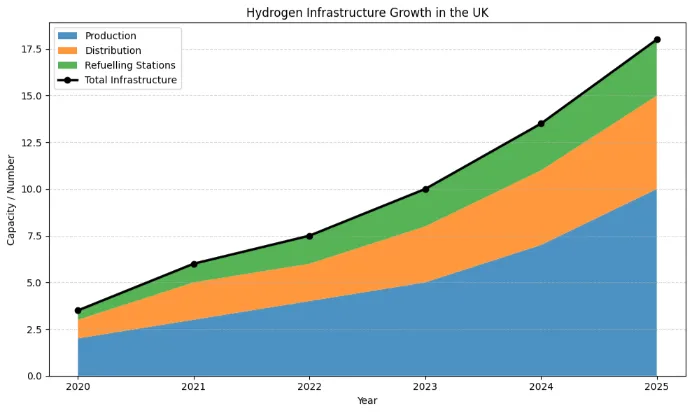
Hydrogen Fuels UK: Overcoming Challenges and Roadmap to Clean Transport
Hydrogen fuels in the UK are key to the nation’s plan to cut carbon emissions in the transport sector. However, many challenges stand in the way of their widespread use. Tackling these issues is vital for the UK to remain a leader in zero-emission technology and meet its net-zero goals. Here’s an overview of the obstacles and the developing plan for hydrogen-powered clean transport.
Key Challenges in Hydrogen Fuels UK Adoption
1. Infrastructure Gaps
A major issue is the lack of permanent hydrogen refuelling stations. Only about 25% of public transport operators in the UK have access to these facilities, limiting the growth of hydrogen-powered fleets. This problem is worsened by the need for on-site hydrogen generation or local electrolysis, especially in areas where refuelling stations are not yet feasible.
2. Safe Storage and Distribution
Hydrogen is difficult to store and transport because of its low density and high flammability. About 76% of UK stakeholders view safe storage as a significant barrier to the large-scale use of hydrogen vehicles. Solutions like decentralized storage and smaller, local electrolysers are being explored to address this gap, at least until national infrastructure develops.
3. Regulatory and Commercial Barriers
The rules around hydrogen fuels in the UK are still evolving. In the maritime sector, for instance, the slow pace of approvals for vessel designs and inadequate port facilities hinder progress. The Regulatory Horizons Council suggests speeding up approvals, creating clearer risk assessment guidelines, and designating class societies as ‘Approved Bodies’ to facilitate the deployment of hydrogen vessels.
4. Funding and Competitive Support
Although the UK government is funding hydrogen innovations, there are worries that this support lags behind other countries. European governments often cover up to 80% of the higher costs of green fuel vehicles, while UK funding is currently less generous. This gap could lead to a “brain drain” and put the UK at a disadvantage unless stronger, cooperative support systems are established.
For more information on UK government hydrogen initiatives, see the official government announcement on hydrogen transport.
5. Production Scale and Green Hydrogen Supply
To satisfy demand, the UK aims to create up to 10GW of new low-carbon hydrogen production capacity by 2030, effectively doubling its initial target. However, increasing the production of green hydrogen—generated from renewable energy through electrolysis—is essential to ensure that hydrogen fuels can provide real reductions in emissions.
6. Technical and Logistical Challenges
Transporting hydrogen from production sites to users is challenging due to its physical properties. Innovations like on-site generation, using ammonia as a hydrogen carrier, and improved pipeline networks are in development but require further investment and clearer regulations.
The Roadmap: Solutions and Strategic Steps
1. Decentralized Production and Refuelling
Using decentralized electrolysis and local hydrogen production will provide easier access to this fuel, especially for early adopters in public transport and commercial fleets. These methods avoid long-distance transport and allow for testing without waiting for national infrastructure to be fully implemented.
2. Policy and Regulatory Reform
The UK government is working on business models and regulations to encourage the production, storage, and transport of hydrogen. The Hydrogen Transport and Storage Business Models, expected to be detailed in 2025, aim to support regional pipeline infrastructure and storage facilities, creating a more robust hydrogen network.
3. Accelerated Investment and Collaboration
For the UK to stay competitive, it must increase its funding for hydrogen vehicles and infrastructure. Public-private partnerships, higher government grants, and alignment with international funding levels are crucial for promoting innovation and adoption.
4. Infrastructure Expansion
The government plans to invest in up to 4GW of CCUS-enabled hydrogen and establish up to 10GW of new low-carbon hydrogen capacity by 2030. Improving refuelling stations, decentralized storage, and supply chain logistics will support the growth of hydrogen fuels in the UK.
5. Research, Standards, and Safety
Ongoing research into the safe storage, handling, and transport of hydrogen is essential. Developing new standards, checklists, and safety procedures—especially for new applications like hydrogen-powered ships and off-road vehicles—will help reduce investment risks and promote wider use.
6. Integration with Renewable Energy
Placing electrolysers close to renewable energy sources allows for green hydrogen production at the site, cutting down on distribution costs and emissions. This method supports the UK’s broader renewable energy strategy and strengthens the sustainability of hydrogen fuels.
Learn more about hydrogen technology and its applications from the Institution of Gas Engineers and Managers.
Outlook: The Path to Clean Transport
The UK’s hydrogen fuels roadmap is ambitious yet achievable through coordinated efforts. By addressing infrastructure, regulatory, funding, and technical challenges, the UK can secure its position as a global leader in hydrogen mobility. Focusing on increasing production, expanding infrastructure, and fostering innovation will not only reduce transport emissions but also create jobs and boost economic growth.
In summary, overcoming the challenges facing hydrogen fuels in the UK requires a broad approach. This includes policy reform, infrastructure investment, industry partnership, and a commitment to green hydrogen production. Taking these steps can power the UK’s journey toward a cleaner, net-zero transport future.